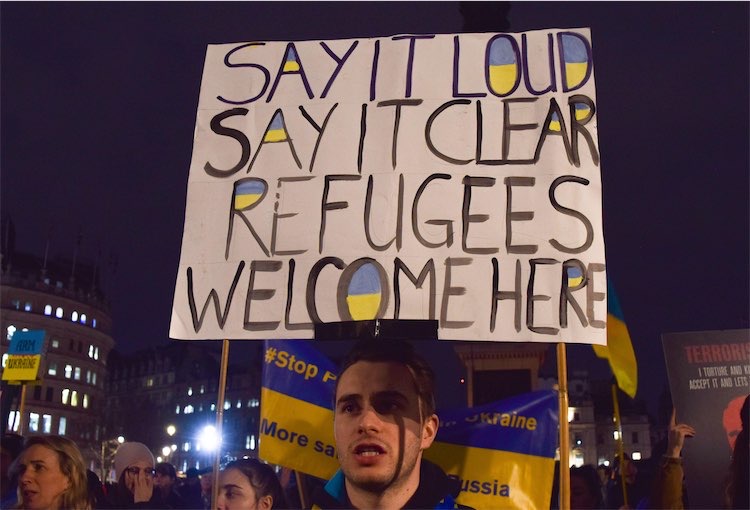Why Has UK Net Migration Reached A Record High?
Net migration to the UK has reached a record high (Alamy)
7 min read
Net migration to the United Kingdom has already reached a record high, with the Office for National Statistics (ONS) expected to announce a further increase on Thursday.
An estimated 504,000 more people came to the UK between June 2021 and June 2022.
Migration numbers have accelerated despite Brexit reducing the number of EU migrants entering the UK. By August 2022, the ONS showed that since the 2016 EU referendum, European migration to the UK had fallen by 72 per cent, whereas immigration from non-EU countries had increased by 95 per cent.
Prime Minister Rishi Sunak’s made a pledge to “Stop the boats” and reduce illegal migration in 2023, indicative of the government’s priority to reduce overall migration numbers under political pressure from anti-immigration groups. But because illegal migration figures are not included in net migration, and many of those who arrive in this way are not granted permission to stay, the number of people crossing the Channel contributes only a tiny fraction to overall migration numbers.
Here is what you need to know about why net migration numbers are so high in the UK:
Refugee resettlement schemes from Ukraine, Afghanistan, and Hong Kong
 Polling showed strong public support for Ukranian refugee resettlement programmes in 2022 (Alamy)
Polling showed strong public support for Ukranian refugee resettlement programmes in 2022 (Alamy)
Hundreds of thousands of refugees have been displaced due to ongoing conflicts around the world in the past year.
Transport Secretary Grant Shapps told Sky News he was “proud” of the UK’s record on allowing high numbers of refugees, and that they accounted for a large proportion of migration figures.
“This country has had a big heart, we’ve opened the country for Ukrainian refugees, for British nationals from Hong Kong,” he said.
“Take those two groups alone and it’s well over 300,000 of these numbers. And then of course we’ve had people from Syria and elsewhere. So actually, I’m rather proud of our record.”
The UK has taken in more than 200,000 Ukrainian refugees since Russia launched its full-scale invasion of the country in February 2022.
There was initially strong public support for the UK offering Ukrainians entry without a visa, with YouGov polling showing three-quarters of people supporting resettling Ukrainians in the UK in March 2022. Polling showed continued strong public support for the government’s Homes for Ukraine scheme later by the end of 2022.
After the Taliban took control of Afghanistan’s capital city Kabul in August 2021, the UK government launched the Afghan Citizens Resettlement Scheme, through which 4,629 refugees were resettled in the UK in 2022.
At the beginning of 2021, when China started to impose stricter authoritarian security laws on Hong Kong, the UK introduced the British National (Overseas) visa to allow individuals in Hong Kong the right to British citizenship and indefinite leave to remain in the UK.
More than 105,000 people have since moved from Hong Kong to the UK since the scheme began.
International students have come to the UK in increased numbers
 The number of international students attending UK universities is increasing (Alamy)
The number of international students attending UK universities is increasing (Alamy)
International students make up a very large proportion of immigration to the UK: In the year ending September 2022, a record number of 463,315 sponsored study visas were granted.
Although international student numbers took a hit during the Covid-19 pandemic, levels have since not only recovered, but increased beyond pre-pandemic levels.
The government published the International Education Strategy in 2021, which set a target to increase the numbers of international students, arguing that this could boost income from the university sector to £35bn a year through tuition fees and spending on accommodation and leisure by students.
In addition to government targets, there is strong financial incentive for universities to admit international students. According to the Migration Observatory, in the 2020/21 academic year, international students made up 22 per cent of all HE students and tuition fees from non-EU students represented 17 per cent of UK universities’ total income.
However, the government has seemingly started to shift its tone on international students, with Home Secretary Suella Braverman pledging to target “low-quality” courses to reduce foreign student numbers.
This week the government has announced it will restrict international students bringing family members with them to the UK. The Migration Advisory Committee (MAC) has also backed changing the rules so that international master’s students cannot switch to work visas at the end of their studies to allow them to work and remain in the country for an additional two years.
While international students arrive in the UK in large numbers, higher education institutions argue that they bring a net economic benefit to the UK, and have warned against curtailing incentives for foreign students.
Increase in work visas to fill employment gaps
 Immigration to the UK is encouraged where there are chronic labour shortages (Alamy)
Immigration to the UK is encouraged where there are chronic labour shortages (Alamy)
The UK is experiencing a shortage of skilled and unskilled workers across a range of sectors, particularly after thousands of EU citizens left the country after Brexit. Certain groups of workers have been encouraged to live and work in the UK in order to plug the labour gap.
Construction, hospitality, agriculture, and the NHS and social care are all sectors that have been particularly badly affected by labour shortages.
Hundreds of thousands of work visas have been granted in the last couple of years since the Skilled Worker and Health and Care visas were introduced during the pandemic at the end of 2020. The number of ‘worker’ visas increased by 128 per cent to 145,258, by September 2022 compared with 2019, with a significant number of these granted for people to work in overwhelmed NHS services.
It is likely that migration to fill employment gaps will only increase further: Bricklayers and carpenters have recently been added to the government’s shortage occupation list which allows special skilled workers visas to be granted to those who can fill the gaps, and Prime Minister Rishi Sunak announced last week that an additional 10,000 seasonal agricultural visas could be issued if needed this year.
Former environment secretary George Eustice told PoliticsHome that the number of overseas workers who come to the UK to pick fruit and vegetables is likely to go up in the next few years, despite the government's insistence they will come down.
Illegal boat crossings aren't a driving factor in net migration increases
 "Stop the boats" is one of Rishi Sunak's new year government pledges (Alamy)
"Stop the boats" is one of Rishi Sunak's new year government pledges (Alamy)
Illegal crossings of the Channel have been at the forefront of the political debate over migration, while only actually contributing to a small proportion of migration figures – in fact, the ONS has stated that its long-term migration statistics do not include “irregular migration” arriving via illegal means.
The number of people arriving in the UK on small boats is estimated to have increased from just over 13,000 in 2018 to more than 52,000 in 2022.
However, it is difficult to determine an exact number, and as these people are usually trying to claim asylum, they do not fit the ONS definition of long-term migration: “A person who moves to a country other than that of his or her usual residence for a period of at least a year, so that the country of destination effectively becomes his or her new country of usual residence.”
Net migration is the most common measure for the overall scale of migration in the UK, taking into account those leaving and arriving in the country. The ONS determines these statistics through administrative and survey data, with some estimations where they consider data to be incomplete.
The ONS data is therefore limited in what it can reveal about the demographics of those leaving and arriving in the UK, their reasons for doing so, and what impact migration has on the country and local communities.
